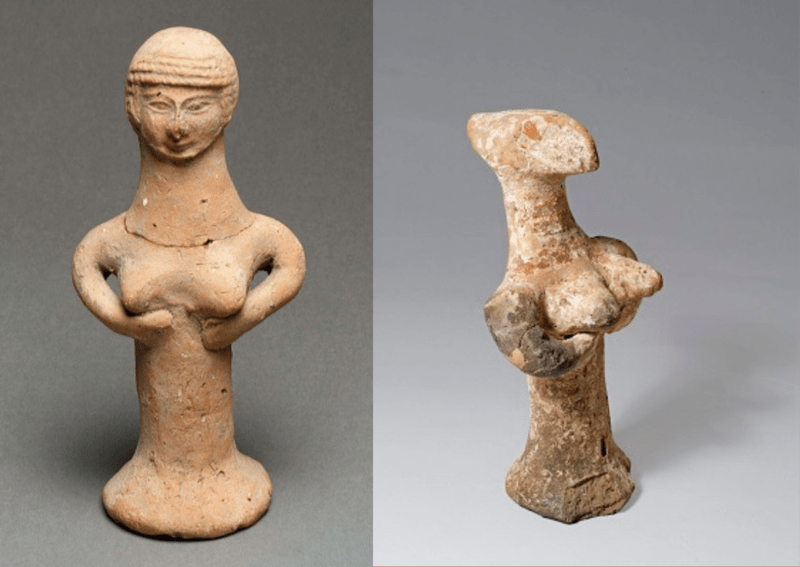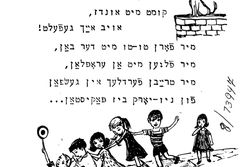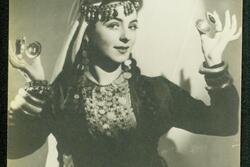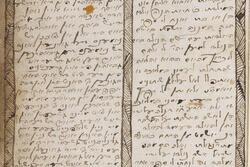From the Archive: Judahite Pillar Figurines
What We Found
You don’t need to be a Bible scholar or even a Sunday school graduate to know that idolatry is, shall we say, frowned upon in the Torah. In the Ten Commandments, God decrees, “You shall not make for yourself a sculptured image, or any likeness of what is in the heavens above, or on the Earth below, or in the waters under the Earth. You shall not bow down to them or serve them” (Exodus 20:4–5). This prohibition, which in English is often quoted as forbidding “graven images,” serves as the basis of our understanding of Judaism as a monotheistic religion incompatible with idolatry.
Despite this, some of the most common artifacts from the biblical territory of Judah are Judahite Pillar Figurines—which look a lot like idols. They often have molded heads with curly hair, atop pillar-like bodies, featuring large breasts held by the figure’s arms. This one, featured in The Posen Library, stands about seven inches tall. Scholars still aren’t sure what these figures are. Do they represent goddesses? Lactating women? Implements for fertility cults? And how will understanding them help us understand the culture from which the Hebrew Bible emerged?
Why It Matters
Artifacts like this one present a tension between the Bible and the archeological record from the ancient Levant. If we look at the Bible itself, the issue of idols is one of the keenest tensions within the text. It is full of references to figurines, statues, and idols. In Genesis, Rachel steals her father Laban’s idols before she flees his home with Jacob and the rest of their family (Genesis 31:19). In Exodus, the Golden Calf, which Israelites built while Moses was on Mt. Sinai receiving laws from God, represents the gravest sin that the people commit in the desert before entering the land of Canaan (Exodus 32). In the book of Kings, we learn that the king of the Northern Kingdom of Israel, Jeroboam, sets up alternate temples with calf statues, which scholars and readers have noted seem to resemble the Golden Calf in the Exodus story (1 Kings 11). Indeed, on numerous occasions, idols become the source of drama.
Still, actually seeing a statuette like a Judahite Pillar Figurine is another matter. These artifacts might make some viewers uncomfortable, as they could be physical evidence of transgression against the biblical prohibition, which has remained central to the Jewish religion. These figures are dated to a time after Judeans had already begun to worship the God of the Hebrew Bible, but scholars still have not reached a consensus around what these figurines were used for, or how they were viewed in their historical context.
In reality, they may have served multiple purposes. Scholar Ian Douglas Wilson argues that their prevalence in Judea in the seventh century BCE could be seen as an act of “ethnic differentiation,” in response to the encroachment of the powerful Assyrian Empire, which by then had already conquered the Northern territories of Israel. He writes that Judahite Pillar Figurines “therefore reflected an attempt by the Judean populace to maintain ethnic identity on the periphery of the Assyrian empire, yet this attempt also created a local cultural phenomenon: the figurines exploded in popularity like never before.” Wilson even notes that they are decorated in a specifically Judean style. According to this argument, one powerful aspect of these figurines was their ability to assert Judeanness.
But these figurines are more than “transgressions” against Jewish law. They’re also powerful symbols and allusions to a common biblical theme relating to women: infertility. From Sarah and Rachel in Genesis, to Hannah in the book of Samuel, the Bible is filled with stories of women who have challenges conceiving. This is perhaps the experience of womanhood that the Bible gives the most space to. While we cannot say definitively what these figurines meant to those who kept them in their homes, we might understand them as “prayers in clay,” to use the words of scholar Ziony Zevit. We can see how the figurines, along with the stories in the Bible, contributed to the prominence of fertility in the ancient culture.
As discussed in a previous From the Archive column about an eighteenth century register of a Jewish midwife housed by The Posen Library, there’s something incredibly moving about seeing how fertility, reproductive health, and childbirth have been an important part of Jewish culture and civilization for millennia. Indeed, these (seemingly transgressive yet widespread) figurines can illuminate the transhistorical issue of fertility, and the complex social role of reproduction and cultural identity in Judea in the eighth and seventh centuries BCE.
Fun Fact
As mentioned above, Hannah, mother of the prophet Samuel is one such biblical woman who struggles with fertility. In the beginning of the Book of Samuel (1 Sam 1:1–2:10, read on Rosh Hashanah), Hannah comes to the Temple to pray for a child. Hannah’s silent prayer later becomes a model for silent prayer in the Jewish tradition. But in the story, the priest, Eli, witnesses her prayer and thinks that she is drunk initially, because her mouth is moving, but no sound emerges. Eli eventually tells her that she will have a child, and she promises to give the baby to him as a Nazarite, in service to God and the temple. This story of coming to the official Temple to pray for a child looks pretty different to us, once we consider the presence of these “unofficial” religious objects. Maybe another woman would have turned instead to a statue like this one.
This post is part of JWA’s From the Archive column. It was written in partnership with The Posen Library of Jewish Culture and Civilization.









